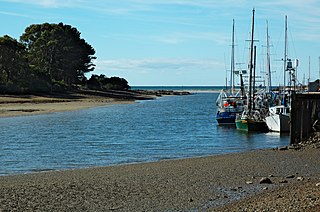
King Island is an island in the Bass Strait, belonging to the Australian state of Tasmania. It is the largest of three islands known as the New Year Group, and the second-largest island in Bass Strait. The island's population at the 2016 census was 1,585 people, up from 1,566 in 2011. The local government area of the island is the King Island Council.
Beddomeia is a genus of very small freshwater snails that have a gill and an operculum, aquatic operculate gastropod mollusks in the family Tateidae.
Beddomeia capensis is an aquatic operculate gastropod mollusk, a species of very small freshwater snail that has a gill and an operculum, in the family Hydrobiidae. The species is classified as endangered and known to be endemic to five streams within a relatively small area on the island state of Tasmania, Australia. However, recent surveys have only been able to locate Beddomeia capensis in two small streams on Table Cape, with the total length of inhabited stream less than 80 metres (260 ft).

Beddomeia fultoni(B. fultoni) is a species of small freshwater snail belonging to the family Tateidae.
Beddomeia launcestonensis is a species of very small freshwater snail that has a gill and an operculum, an aquatic operculate gastropod mollusk in the family Hydrobiidae. This species is endemic to Australia.
Beddomeia tumida is a species of very small freshwater snail that has a gill and an operculum. It is an aquatic operculate gastropod mollusc in the family Hydrobiidae, and is endemic to Australia.
Beddomeia waterhouseae, also known as Claytons Rivulet freshwater snail, is a species of freshwater snail in the family Tateidae. This species is endemic to northern Tasmania in Australia. The holotype specimen was found in a very small tributary of Little Clayton's Rivulet and is held at the Australian Museum. B. waterhouseae is small and as an adult has a shell measuring between 1.7 to 3.7 mm in length. The shell shape is ovate-conic to broadly conic and has a thin inner lip and no columellar bulge. This species feeds on algae and detritus on rocks. The female of the species lay single eggs in capsules made of sand grains and attached to the underside of rocks or wood. B. waterhouseae is considered vulnerable by the IUCN as it has a very small range and is sensitive to water quality and so may be threatened by disturbances of its habitat. Other threats include habitat loss. Conservation activities such as assessment of the aquatic ecosystem and vegetal surveys are being undertaken in an attempt to preserve this species.
Attenborougharion rubicundus is a species of air-breathing semi-slug, terrestrial pulmonate gastropod molluscs in the family Helicarionidae.
Pasmaditta jungermanniae is a species of land snail in the family Punctidae, the dot snails. It is known by the common name Cataract Gorge snail. It is endemic to Tasmania in Australia, where it is known from only one location.
Roblinella agnewi is a species of small land snail in the family Charopidae. This species is endemic to Tasmania in Australia, where it is known only from Mount Wellington. It is known commonly as the silky snail.
Tasmaphena lamproides is a species of land snail in the family Rhytididae. It occurs in north-western Tasmania and probably far southern Victoria. It is known by the common name keeled snail.
Phallomedusa solida is a species of small, air-breathing land snail with an operculum, a pulmonate gastropod mollusc in the family Phallomedusidae.
The Bass Pyramid, part of the Furneaux Group, is a small, two sectioned oval, steep-sided 100-square-metre (1,100 sq ft) unpopulated granite island, located in Bass Strait, lying north of the Flinders Island and south of the Kent Group, in Tasmania, Australia. A rock bridge connects the two sections.

Cernuella virgata, also known as Helicella virgata, common name, the "vineyard snail", is a species of small, air-breathing land snail, a pulmonate gastropod mollusc in the family Geomitridae, the hairy snails and their allies.

The Inglis River is a river in North West Tasmania, Australia, it extends approximately 61 kilometres (38 mi) from the Campbell Ranges near Takone before discharging into Bass Strait at Wynyard. The Flowerdale River is the largest tributary system on the Inglis River and makes up approximately one-third of the 471-square-kilometre (182 sq mi) Inglis-Flowerdale catchment basin.

Freshwater snails are gastropod mollusks which live in fresh water. There are many different families. They are found throughout the world in various habitats, ranging from ephemeral pools to the largest lakes, and from small seeps and springs to major rivers. The great majority of freshwater gastropods have a shell, with very few exceptions. Some groups of snails that live in freshwater respire using gills, whereas other groups need to reach the surface to breathe air. In addition, some are amphibious and have both gills and a lung. Most feed on algae, but many are detritivores and some are filter feeders.

Asperdaphne bela is a species of sea snail, a marine gastropod mollusk in the family Raphitomidae.

Truncatella scalarina is a species of very small land snail that lives next to seawater, a gastropod mollusk or micromollusk in the family Truncatellidae.

Notocypraea piperita, common name peppered cowrie, is a species of sea snail, a cowry, a marine gastropod mollusk in the family Cypraeidae, the cowries.

Table Cape is a extinct volcano located near Wynyard on the North West of Tasmania, Australia, it is also the name of the locality which encompasses the geological feature. Table Cape is a more or less circular extinct volcano with a flat top, its northern and eastern faces rise steeply from Bass Strait to a height of approximately 170 metres (560 ft) above sea level. It was named by British navigator, Matthew Flinders, as he and George Bass circumnavigated Van Diemen's Land in 1798 upon the Norfolk. Flinders also progressively named the nearby Circular Head, Three Hummock and Hunter Islands.









